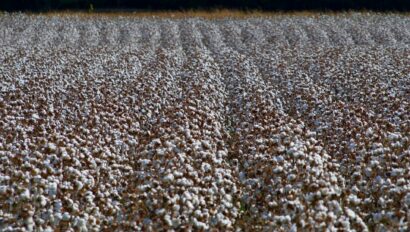New Website Focuses on Textiles Made from Sugars, Biomass and Plant Oils
CONTACTS: Donna Worley
Director of Communications and Public Relations
+1.806.577.0652 (U.S. Central)
Donna@TextileExchange.org
January 16, 2018, Lamesa, Texas — In the future, we could be wearing clothes made from sugars, plants, algae, fungi and bacteria. Even today, our shirts could be made from sugar cane and our stockings from castor oil beans. The rapidly developing technologies of the biosynthetics which make this possible are revealed and explained in a new website launched by Textile Exchange and backed by an industry-wide Working Group.
aboutbiosynthetics.org is the latest in the suite of Textile Exchange’s “About” series following on from its aboutorganiccotton.org released in 2015. As with aboutorganiccotton, the biosynthetics microsite aims to demystify the subject and provide soundly based information and market intelligence for businesses and interested consumers alike.
“Right now, biosynthetics are a new and emerging area for the textile industry and an exciting one for us to be exploring at Textile Exchange. We are all looking for opportunities to reduce our dependency on fossil fuels and reduce carbon emissions. Fibers made from polymers based on plants and other biological inputs offer huge potential.
“Many of our members are curious about the technology but are asking questions about the sustainability opportunities biosynthetics offer. Our new microsite is a tool for communicating the big potential biosynthetics offer and their link to the Bio Economy, while also presenting the challenges and realities in terms of the sector’s stage of development and current scale,” said Liesl Truscott, Director of Materials Strategy, Textile Exchange.
“We think the Textile Exchange microsite is a great way to provide much needed information on the benefits of biosynthetic materials to the textile industry” said Stacey Orlandi, CEO of Virent. “At Virent we are in the final stages of commercializing a technology to use plant-based feedstocks to produce paraxylene, a key raw material for bio-polyester fiber. We were pleased that Textile Exchange took on the challenge of developing the microsite and are happy to support its continued development.”
In 2016, Textile Exchange set up a Biosynthetics Working Group. The Working Group is comprised of Textile Exchange members and experts (listed below) with an interest in the future of bio-based materials as a solution to transitioning out of non-renewables and textiles based on petroleum towards more sustainable alternatives. The multi-stakeholder group, led in its incubator phase by Sophie Mather of biov8tion, has focused on exploring the opportunities, challenges, barriers to growth, sustainability benefits and, importantly, how to get biosynthetic from R&D and proof-of-concept to market readiness and a commercially viable alternative to virgin materials.
“As pressure on resources grows, the need to innovate and commercialize a varied portfolio of renewable bio based synthetics is more important than ever. The entry level communication included in the microsite will enable Textile Exchange to level set understanding across brands, retailers and supply chain partners to help expedite a collective understanding and move the agenda forwards. It has been exciting to kick start the shape of the microsite and I look forward to seeing how it develops in line with the fast-developing industry sector”. Sophie Mather, biov8tion
“I don’t think there’s anything else offering a platform quite like this to the textile industry and we have been so lucky to have had Sophie / biov8tion at the helm, and input from world leaders in biosynthetics such as Virent, Dupont, Natureworks, Fulgar, Far Eastern New Century and others in the Working Group,” said Truscott.
The Working Group meets in-person each year at the Preferred Fiber & Materials Round Tables day, held in Washington DC at Textile Exchange’s 2017 Textile Sustainability Conference, as well as having virtual meetings throughout the year. 2018’s in-person meeting will be held Milan, the home of fashion but also of much innovation in new fibers and technologies.
“Norrøna is excited about the possibilities bio-synthetic fibers offer to reduce the textile industry’s dependence on oil. The building of this website is the first step towards education and promotion of cleaner and more innovative ways to produce our synthetic products. As a brand, Norrøna is committed to being a catalyst to maximize this opportunity through a clear roadmap which will benefit the fiber producers, mills, brands and consumers ensuring we reduce greenhouse gases as part of the bio-synthetic development. Bio synthetics have the potential to be the biggest industry game changer since the original discovery of synthetic fibers over ninety years ago.” Brad Boran, Director of Innovation & Sustainability, Norrøna
Textile Exchange would like to warmly thank all who contributed to the development of the microsite, with special thanks to Sophie Mather, Working Group Lead.
biov8tion
adidas
Anellotech
ASOS
Clarks
Columbia
DuPont
European Outdoor Group
Far Eastern New Century
Fulgar
GAP, Inc.
H&M
Inditex
Kathmandu
Kering Group
Natureworks
Nike Inc.
Norrona
Novozymes
Patagonia
REvolve Waste, LLC
Toray
University of Hohenheim
Vaude
VF Corporation
Virent
For more information on the Biosynthetics Working Group please contact the Materials Team: Materials@TextileExchange.org.
ABOUT TEXTILE EXCHANGE
Textile Exchange, founded in 2002, is a global nonprofit organization that works closely with all sectors of the textile supply chain to find the best ways to create positive impacts on water, soil, air, animals, and the human population created by the textile industry. Textile Exchange accomplishes this by providing the knowledge and tools the industry needs to make significant improvements in three core areas: Fiber and Materials, Integrity and Standards, and Supply Network. A truly global organization, Textile Exchange is headquartered in the U.S. with Staff and Ambassadors located around the world. To learn more about Textile Exchange, visit: www.TextileExchange.org and follow us on Twitter at @TextileExchange.


